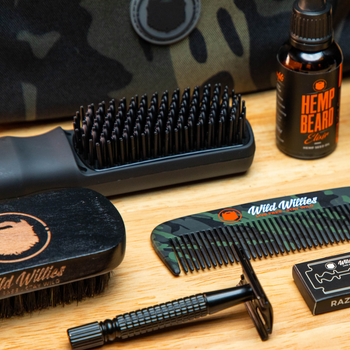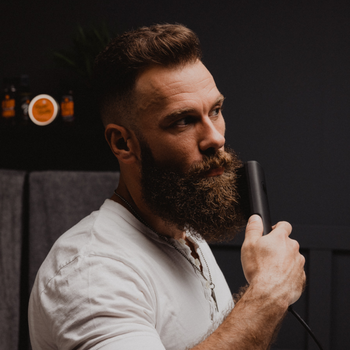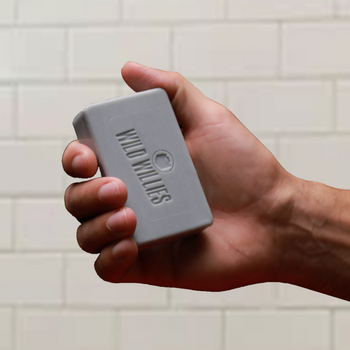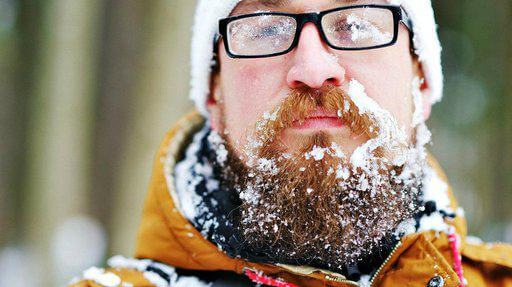If you think you'll never get beard dandruff, then you're in for a surprise. It happens to the best of us, after all. Those specks in your beard? They may not be crumbs, dude. Dandruff isn’t always confined to the scalp. It’s a gross fact of life, but anywhere your body sprouts hair is a honey trap for the flaking skin underneath. And the darker your beard, the more unsightly the problem. It can take some experimenting to find the cause, which leads to the best treatment. But once you do, your “crumb catcher” can go back to its day job.
In this article:
- The Bad Guys
- Brush it Off, Bro
- Lather Up!
- Real Guys Moisturize
- What About Dandruff Shampoo?
- How to Prevent Beard Dandruff
How To Get Rid Of Beard Dandruff
The Bad Guys

“Why you flakin’ on me, bro?” Just like scalp dandruff, “beardruff” can spring from a few different causes. The most common culprits are:
- Dry skin. Dry, irritated skin is, well, irritating no matter what. But once the resulting flakes start to festoon your luscious beard, they’re all the more noticeable. To find out if it’s simple dehydration that’s causing your beardruff, do a little detective work. Part those facial locks and peer underneath. If the skin doesn’t seem red or rashy, the root cause is probably regular, garden-variety dry skin.
- Neglect. Ironically, the opposite problem—excessive oiliness—also leads to beard dandruff. Guys who don’t wash their beards often enough are letting oil and trapped skin cells build up in their facial hair. When that happens, the oils and cells break down into flakes.
- “Hyper” skin. Everybody’s skin renews its cell supply every month or so. But you could be one of those people whose skin cells turn over at a faster rate. When that happens, the cells accumulate on top of your skin—and beard—rather than falling away unobtrusively.
- A fungus among us. That’s right! Fungal infections are one of the top reasons scalp and beard dandruff happen. These tiny fungal microbes are actually supposed to be there, helping to break down natural oils. But if there’s more oil than usual, or your skin just reacts badly to the microbes, they multiply. The resulting fungal infection causes redness, itching, patchy redness—and, of course, the dreaded beardruff.
Brush it Off, Bro
Your first step toward getting rid of the problem is removing the buildup of dead skin cells. That means exfoliation. For guys, the best method for this is a soft-bristled beard brush. Before you get into the shower, brush your beard thoroughly. What you’re doing is sloughing off the dead skin cells under your beard.
As a bonus, you’re also redistributing your beard’s natural oils. And that’s a good thing—whether your facial hair is too dry or too oily. Brushing it helps redistribute those natural oils more evenly.
Lather Up!
Now that you’ve got your skin cells good and loosened through brushing, it’s time to get into the shower and wash them away. (You can do this at the sink, obviously, but the steam from the shower helps open up the pores even more.)
A great beard wash not only keeps your facial hair clean, but it also helps carry away the flakes you’ve just brushed to the surface. Just as importantly, a good-quality beard wash has hydrating ingredients that address ongoing flaking problems.
Work the beard wash into your beard so that your fingers are gently massaging the skin underneath. This action is bringing more dead skin cells to the surface while stimulating healthy growth underneath. Keep the beard wash on for a minute or two, while you wash your hair and body. Then rinse it away completely, making sure not to leave any residue.
Real Guys Moisturize
There are a couple of ways to bring relief to irritated facial skin, whether dandruff comes from regular dryness or from fungal-irritated skin. Using a beard conditioner after your beard wash is one way. Look for a softening beard conditioner with natural essential oils. Work it into your beard after you’ve used your beard wash.
Next, consider a beard oil. Beard oils are key beard dandruff home remedies for two reasons. They give the facial hair itself a protective coating. Secondly, they penetrate to the skin underneath. Warm the oil in your hands, then work it into throughout your beard area.
What About Dandruff Shampoo?
Technically, your beard is on your head, so does that mean your trusty ol' anti-dandruff shampoo will work on beard dandruff? Well, if you're in a fix you're welcome to try, but we're not big fans of using regular shampoo on our beards.
However, technically speaking, shampoos containing pyrithione zinc is a good all-around treatment for dandruff in beard. The active ingredient addresses a number of potential dandruff causes, including fungal- and bacterial-based ones, helping you get rid of beard dandruff.
If the problem is severe, try a beard dandruff shampoo that contains ketoconazole, a stronger ingredient. The only type of scalp shampoo to avoid? Those that contain selenium disulfide, which demands more regular use than is prudent for beards.
How to Prevent Beard Dandruff
Even if it’s been a while since you’ve seen those pesky flakes, you’re probably dreading their return. The main trick is not to let up on your anti-beardruff routine—but don’t overdo it, either. Too much washing, especially with dandruff shampoos, can actually irritate and dry out your skin. And that means more flakes.
At the same time, going back to total neglect is yet another recipe for Beardruff 2: Electric Boogaloo. Remember, letting too much oil accumulate in your beard, coupled with a lack of exfoliation, leads to flake buildup.
Along with keeping up your current routine, adjusting for weather and personal changes is also important. In cold, dry weather, a bit of extra beard oil is one of the better beard dandruff home remedies. If you’ve noticed a fungal outbreak on your scalp or between your eyebrows, it might be a good idea to use your medicated dandruff shampoo once or twice a month.
Here are other issues on growing beards plus some solutions by Wild Willies:
We get it—dandruff is a gross subject. But as queasy as it may make you feel to research it, imagine how it feels to live with it! That’s why nipping the problem in the bud ASAP is practically a public service.
Do you know other beard dandruff home remedies? Impart your knowledge in the comments section below!
Up Next: Beard Balm Vs Beard Oil: Which One Should You Use







